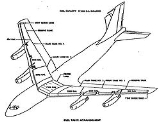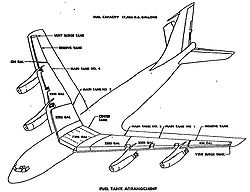
Pan Am Flight 214
Encyclopedia
Pan Am Flight 214, a Boeing 707-121
registered as , was en route from Baltimore
to Philadelphia
on December 8, 1963, when it crashed near Elkton, Maryland
after being hit by lightning
, killing all 81 on board.
at 4:10pm EST for a flight to Baltimore's Friendship Airport (now Baltimore-Washington International Thurgood Marshall Airport
, or BWI), where 69 passengers disembarked. At 8:24pm EST, flight 214 departed for Philadelphia with 73 passengers and 8 crew members on board. Because of high winds in the area, the crew chose to wait in a holding pattern with five other airplanes rather than attempt to land in Philadelphia.
At 8:58pm EST, while in the holding pattern, the aircraft was hit by lightning
, which ignited fuel vapors in the No. 1 (left) reserve tank, causing an explosion that blew apart the outer portion of the jetliner's port wing. The crew of Flight 214 managed to transmit a final message – "Mayday, mayday, mayday ... Clipper 214 out of control ... here we go" – before it crashed near Elkton, Maryland
. All 81 people on board were killed.
 The Civil Aeronautics Board (CAB) investigated the accident, and issued the following Probable Cause statement on March 3, 1965:
The Civil Aeronautics Board (CAB) investigated the accident, and issued the following Probable Cause statement on March 3, 1965:
It is now thought that the lightning strike that caused the ignition was a rare positive lightning bolt.
ordered lightning discharge wicks (or Static discharger
) to be installed on all commercial jets flying inside U.S. airspace.
Boeing 747 crash on July 17, 1996, with 230 fatalities, which was also determined to have been caused by the explosion of a volatile mixture inside a fuel tank.
(In 1971, LANSA Flight 508
was also brought down by a lightning strike. However, though this crash would have more total casualties (91 fatalities), up to fourteen passengers survived the crash but perished waiting for help in the Peruvian jungle.)
Boeing 707
The Boeing 707 is a four-engine narrow-body commercial passenger jet airliner developed by Boeing in the early 1950s. Its name is most commonly pronounced as "Seven Oh Seven". The first airline to operate the 707 was Pan American World Airways, inaugurating the type's first commercial flight on...
registered as , was en route from Baltimore
Baltimore-Washington International Thurgood Marshall Airport
Baltimore/Washington International Thurgood Marshall Airport is an international airport serving the Baltimore-Washington Metropolitan Area in the United States. It is commonly called BWI, BWI Airport or BWI Marshall, BWI being an initialism for "Baltimore/Washington International" and the...
to Philadelphia
Philadelphia International Airport
Philadelphia International Airport is a major airport in Philadelphia, Pennsylvania, United States, and is the largest airport in the Delaware Valley region and in Pennsylvania...
on December 8, 1963, when it crashed near Elkton, Maryland
Elkton, Maryland
The town of Elkton is the county seat of Cecil County, Maryland, United States. The population was 11,893 as of the 2000 census and 14,842 according to current July 2008 census estimates. It is the county seat of Cecil County...
after being hit by lightning
Lightning strike
Lightning strikes are electrical discharges caused by lightning, typically during thunderstorms.Humans can be hit by lightning directly when outdoors. Contrary to popular notion, there is no 'safe' location outdoors. People have been struck in sheds and makeshift shelters...
, killing all 81 on board.
Flight history
On December 8, 1963, Pan American 214, operated by Clipper Tradewind, departed Isla Verde International Airport in San Juan, Puerto RicoSan Juan, Puerto Rico
San Juan , officially Municipio de la Ciudad Capital San Juan Bautista , is the capital and most populous municipality in Puerto Rico, an unincorporated territory of the United States. As of the 2010 census, it had a population of 395,326 making it the 46th-largest city under the jurisdiction of...
at 4:10pm EST for a flight to Baltimore's Friendship Airport (now Baltimore-Washington International Thurgood Marshall Airport
Baltimore-Washington International Thurgood Marshall Airport
Baltimore/Washington International Thurgood Marshall Airport is an international airport serving the Baltimore-Washington Metropolitan Area in the United States. It is commonly called BWI, BWI Airport or BWI Marshall, BWI being an initialism for "Baltimore/Washington International" and the...
, or BWI), where 69 passengers disembarked. At 8:24pm EST, flight 214 departed for Philadelphia with 73 passengers and 8 crew members on board. Because of high winds in the area, the crew chose to wait in a holding pattern with five other airplanes rather than attempt to land in Philadelphia.
At 8:58pm EST, while in the holding pattern, the aircraft was hit by lightning
Lightning
Lightning is an atmospheric electrostatic discharge accompanied by thunder, which typically occurs during thunderstorms, and sometimes during volcanic eruptions or dust storms...
, which ignited fuel vapors in the No. 1 (left) reserve tank, causing an explosion that blew apart the outer portion of the jetliner's port wing. The crew of Flight 214 managed to transmit a final message – "Mayday, mayday, mayday ... Clipper 214 out of control ... here we go" – before it crashed near Elkton, Maryland
Elkton, Maryland
The town of Elkton is the county seat of Cecil County, Maryland, United States. The population was 11,893 as of the 2000 census and 14,842 according to current July 2008 census estimates. It is the county seat of Cecil County...
. All 81 people on board were killed.
Investigation

It is now thought that the lightning strike that caused the ignition was a rare positive lightning bolt.
FAA reaction
As a result of the crash of Flight 214, the Federal Aviation AdministrationFederal Aviation Administration
The Federal Aviation Administration is the national aviation authority of the United States. An agency of the United States Department of Transportation, it has authority to regulate and oversee all aspects of civil aviation in the U.S...
ordered lightning discharge wicks (or Static discharger
Static discharger
Static dischargers are commonly known as static wicks or static discharge wicks. They are used on aircraft to allow the continuous satisfactory operation of onboard navigation and radio communication systems. During adverse charging conditions , they limit the potential static buildup on the...
) to be installed on all commercial jets flying inside U.S. airspace.
Volatile fuel vapor recommendation
On December 17, 1963, nine days after the crash of Flight 214, Leon H. Tanguay, director of the CAB Bureau of Safety, sent a letter to the FAA recommending several safety modifications as part of future aircraft design. One modification related specifically to volatile fuel vapors that can form inside of partly empty fuel tanks, which may be ignited by various potential ignition sources and cause an explosion. Mr. Tanguay's letter suggested reducing the volatility of the fuel/air gas mixture by introducing an inert gas, or by using air circulation. Thirty-three years later, a similar recommendation was issued by the NTSB (the CAB's successor) after the TWA Flight 800TWA Flight 800
Trans World Airlines Flight 800 , a Boeing 747-131, exploded and crashed into the Atlantic Ocean near East Moriches, New York, on July 17, 1996, at about 20:31 EDT, 12 minutes after takeoff, killing all 230 persons on board. At the time, it was the second-deadliest U.S...
Boeing 747 crash on July 17, 1996, with 230 fatalities, which was also determined to have been caused by the explosion of a volatile mixture inside a fuel tank.
Guinness world record
The crash of Pan Am Flight 214 was registered in the Guinness Book of World Records (2005) as the "Worst Lightning Strike Death Toll."(In 1971, LANSA Flight 508
LANSA Flight 508
LANSA Flight 508 was a Lockheed L-188A Electra turboprop, registered OB-R-941, operated as a scheduled domestic passenger flight by Lineas Aéreas Nacionales Sociedad Anonima , that crashed in a thunderstorm en route from Lima, Peru to Pucallpa, Peru, on December 24, 1971, killing 91 people –...
was also brought down by a lightning strike. However, though this crash would have more total casualties (91 fatalities), up to fourteen passengers survived the crash but perished waiting for help in the Peruvian jungle.)
See also
- Lists of accidents and incidents on commercial airliners
- Air safetyAir safetyAir safety is a term encompassing the theory, investigation and categorization of flight failures, and the prevention of such failures through regulation, education and training. It can also be applied in the context of campaigns that inform the public as to the safety of air travel.-United...
- TWA Flight 800TWA Flight 800Trans World Airlines Flight 800 , a Boeing 747-131, exploded and crashed into the Atlantic Ocean near East Moriches, New York, on July 17, 1996, at about 20:31 EDT, 12 minutes after takeoff, killing all 230 persons on board. At the time, it was the second-deadliest U.S...
- AIRES Flight 8250AIRES Flight 8250AIRES Flight 8250 was a domestic scheduled passenger flight which crashed on August 16, 2010 on the Colombian island of San Andrés, in the Caribbean, with two fatalities. The aircraft, an AIRES-operated Boeing 737-73V, was en-route from the Colombian capital Bogota when it crashed while attempting...
External links
- Civil Aeronautics Board reports – digitized versions

